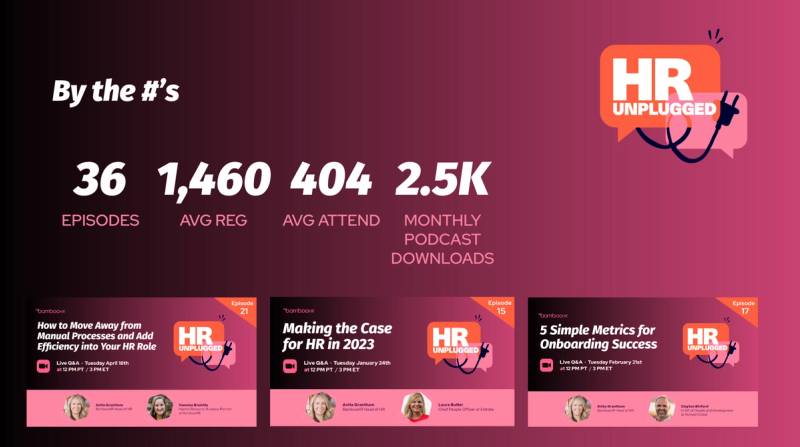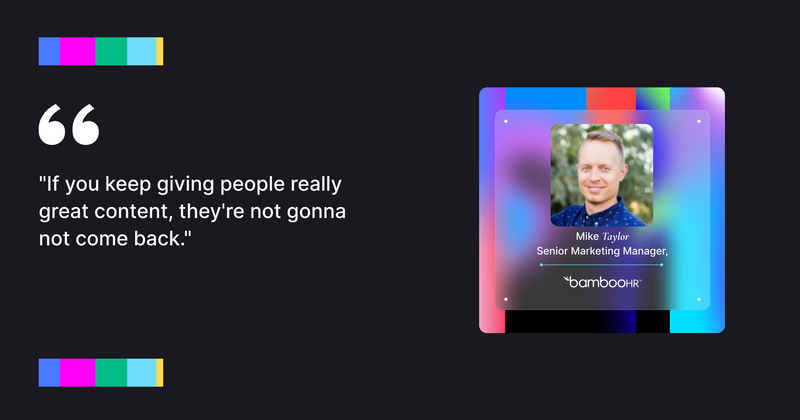How to Make Running an Event Series Easy

Table of Contents
- BambooHR's strategy behind hosting three (yes, three!) series
- What series growth looks like—plus, celebrate your series milestones
- How to combat diminishing returns on your series
- How the Goldcast Series functionality works
- Other processes and tools that can help you run your series
- Metrics to track for your series
Maximize Your Marketing ROI
Join 10,000 other marketers already getting the best tips on running engaging events that boost pipeline and create raving fans.
We've covered a lot of ground with our Series Masterclass so far, talking about things like how to get different departments involved and why your series needs a premise.
As savvy marketers, you might have been wondering throughout the other sessions: But how can I track my ROI? When will I know if my series is successful? And what tools can I use to make this whole series thing easier?
Well, in the third series installment, we covered those questions and more!
We spoke with Mike Taylor, Senior Marketing Manager at BambooHR and Courtney Cohen, our Director of Product. We got some tips directly from Mike, who's been doing virtual events for a decade now (and is currently running three series!). We also got to hear from Courtney about Goldcast's new series feature and saw a little bit of it in action. Read on for:
- BambooHR's strategy behind hosting three (yes, three!) ongoing event series
- What series growth looks like—plus, celebrate your series milestones
- How to combat diminishing returns on your series
- How the Goldcast Series functionality works
- Other processes and tools that can help you run your series
- Metrics to track for your series
📺 If you want to watch the full episode before you devour the top tips, be our guest!

BambooHR's strategy behind hosting three (yes, three!) series
If you need proof that series have value, look no further than BambooHR's programming.
"Just a couple of years ago, series were a swear word for us because you'd start them and get all these diminishing returns. But the series motion is so much better now." - Mike Taylor, Senior Marketing Manager, BambooHR
BambooHR produces the series like a show. They build community and branding around each one, and they've found that they can generate a lot of loyalty this way.
The current series are:
- HR Unplugged, which is mostly about thought leadership and engaging the community. Each series episode also becomes a podcast, which is a great example of repurposing.
- A customer series where the company can engage with customers and teach them about upcoming products.
- A weekly demo webinar series for prospective customers to get their questions answered, with the goal being to drive people toward a personalized demo after the series.
As you can see, there's a lot of diversity here! BambooHR has been very strategic in creating series with very unique audiences and ICPs so that they can appeal to a broad swath of people. If you're just starting out with your own series, however, you'd probably want to pick one and focus all of your energy on growing it before moving into managing multiple event series.
What series growth looks like—plus, celebrate your series milestones
HR Unplugged is released about twice a month. This works well for the podcast episodes too, as the more episodes you put up, the more you're rewarded for consistency. In the months the show does three episodes, Mike sees the numbers skyrocket.

On average, the show gets around 1,500 people registering each time. Of that number, 400 actually attend. There are also 2,500 downloads each month for the podcast episodes.
Pretty impressive, right? Mike shares these stats with speakers when he asks them to do the series so they'll have an idea of what they're agreeing to.
Loading each episode as a podcast has been a huge help. Mike hasn't taken out any paid advertising, but he continues to enjoy organic growth month over month. From March-October of last year, downloads went from 695/month to the current number of 2,500 each month!
HR Unplugged had its first birthday this year, and Mike recommends celebrating that type of thing. Audiences love to join in on celebrating your big landmarks, and it draws more attention to your show.

How to combat diminishing returns on your series
It's a common challenge marketers face: People are excited at the beginning of a series, but then that wears off over time and folks stop showing up. Or maybe they forget to add it to their calendar altogether.
Goldcast's automatic calendar invites can help you get around some of this issue. Sending a registrant a Magic Link and calendar hold makes it easy for them to remember; plus, they'll get reminders leading up to event day. Mike's also playing around with text reminders to reach more people.
However, while calendar and text invites can help logistically, this doesn't really address the decreasing excitement people have about a series. This is why giving people the best content that you can should always be your top priority.
"If you keep giving people really great content, they're not gonna not come back." - Mike Taylor, Senior Marketing Manager, BambooHR

Focus on building your series and its branding. You want people to become loyal to your series and start talking about it with others.
And be patient; it's natural for there to be a surge in interest, then a drop, then another surge with every series. If you continue riding things out, even when you see a drop, you will likely be rewarded with another surge, if you're hosting high-quality events that interest people.
How the Goldcast Series functionality works
The Goldcast team fully embraces the power of series. It's why we run so many of our own!
We started with CMO Diaries, which was hosted by our COO, Kishore Kothandaraman. While it's no longer active, we have a huge library of on-demand episodes you can check out!
Then there's Event Marketers Live, which has been dedicated to our community of event marketers for over a year. And our newest show, Donuts and Demand, is specifically for our demand gen folks.
"At Goldcast, we're dedicated to making sure we can help our customers suit any use case they come to us with." - Courtney Cohen, Director of Product, Goldcast
We've seen firsthand the immense value that comes from investing in a series, and we wanted to make it as easy as possible for our customers to set them up and get started. It's normal to feel overwhelmed when you're first thinking about a series—how in the world are you going to come up with that much regular, valuable content?
But we believe the payoff is more than worth it! Series give you the chance to build communities, fuel demand, and generate pipeline.
Enter: the Goldcast Series experience, which just went live 🎉
Did you know? Videos like the one above and throughout this article were made using Goldcast's Content Lab, an AI-powered content studio that allows you to quickly and easily turn event content into snackable video clips.
From within Goldcast, you can now go to the "Series" section and pull together events inside of a series. Everything will be connected within the platform, and you can manage your series events from one central location.
A few really cool features we want to point out:
- Your event attendees can sign up for multiple events, all at the same time. They don't have to register individually. And they only get one confirmation email!
- You can display info about all upcoming events on one single page. No more switching links depending on which session you're trying to promote!
- You can also host your on-demand content on the same page, in case folks want to catch up on past events.
Note that while registrants get just one confirmation email, they'll still get individual reminders and calendar holds for each event.
Other processes and tools that can help you run your series
Of course, Goldcast can't handle all of the logistics involved with a series—not yet, anyway. Here are some of Mike's other tips!
Find a project management system
Mike uses Wrike for project management. For every series, he duplicates an existing blueprint. Each blueprint contains automation that assigns tasks to others, adds events to internal calendars, pings teams for deliverables, and other tasks.
Speaking of automation, use it whenever possible! Goldcast does have a suite of integrations that can make your life easier, so be sure you're taking advantage of any relevant ones.
Set up a recurring meeting
He also organizes a weekly meeting to talk about BambooHR's series. All of the people who make decisions are present, and the team goes over what they need to know for the upcoming series installment, as well as the next one. Mike tries to keep that group small so that they can keep moving forward and not get hung up on needing too many approvals. (We've all been there, right?)
Make data-driven decisions
Don't forget to get data from your audience to help pick future topics. BambooHR sends out a survey at the end of events to find out what content people liked, as well as what people want to know about in the future. Mike takes it a step further and puts the survey data into a spreadsheet every week that he shares with other people who work on content. That way, everyone's plugged into keywords and audience desires.
Tap your thought leaders
Talk to your internal thought leaders. Mike's found that BambooHR's Head of HR is the perfect resource for supporting HR Unplugged. Sometimes your thought leaders are out there in the field, at the cutting edge of things that are going on. They know your market, and they've got a lot of ideas that can help you.
Develop rules around your content
Outline some rules around your series when it comes to what kind of content you're going to talk about.
For HR Unplugged, Mike knows that it's an awareness play. That means he won't be pitching product—but he should also be talking about things that tie back to the product. That way, when someone scores up in the lead scoring model, a rep can have a convo that leads back to product in a way that makes sense.
While developing rules may seem like too much work, it will actually speed things up because your decision-making in the future will be clear. You'll know immediately what types of content or ideas won't work and which ones align with your rules.
Use a dedicated writer and consider outsourcing
Consider hiring a dedicated contractor for abstracts, emails, and other copy help. Mike uses one for his series and it makes it a lot easier to manage. He'll sometimes start with Goldcast's Content Lab to give the writer an AI-powered draft as a head start, and then the writer freshens it up and gets it moving forward in no time.
Metrics to track for your series
Mike likes to rank his series using attendance and podcast downloads as criteria. From there, he uses the ranking system to see what the top sessions are, as well as the content that people are most interested in.
Other things he tracks:
- Email performance within Goldcast
- Audience engagement at events: chat messages, questions, polls, etc.
- Subscribers
- Down-funnel metrics: he pushes the data from Goldcast to Salesforce to review things like MQLs, sales accepted opportunities, closed-won, etc.
He also looks out for "hot moments" in a webinar when everyone starts chiming in to the chat. During those times, he drops the link to the BambooHR community and sends folks scrambling to join.
And if you're wondering whether Goldcast series functionality allows you to track some of the above data, the answer is yes! Check out the video below for a quick walkthrough from Courtney:
As you can see, you'll be able to quickly identify your top performers and keep a finger on the most important metrics. We're super excited to see all of your new series hit the platform soon.
In the meantime, don't forget to catch up on the entire replay below!

Transform Your Video Marketing with AI
Stay In Touch
Platform
Resources
© 2025 Copyright Goldcast, Inc. All rights reserved.





 Upcoming Events
Upcoming Events Event Series
Event Series On-Demand Events
On-Demand Events

